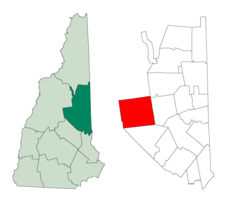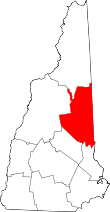Sandwich, New Hampshire
| Sandwich, New Hampshire | |
|---|---|
| Town | |
 Location in Carroll County, New Hampshire | |
| Coordinates: 43°47′27″N 71°24′40″W / 43.79083°N 71.41111°WCoordinates: 43°47′27″N 71°24′40″W / 43.79083°N 71.41111°W | |
| Country | United States |
| State | New Hampshire |
| County | Carroll |
| Incorporated | 1763 |
| Government | |
| • Board of selectmen |
Willard G. Martin Toby Eaton Bob Rowan |
| Area | |
| • Total | 93.5 sq mi (242.1 km2) |
| • Land | 90.2 sq mi (233.7 km2) |
| • Water | 3.2 sq mi (8.4 km2) 3.47% |
| Elevation | 797 ft (243 m) |
| Population (2010) | |
| • Total | 1,326 |
| • Density | 14/sq mi (5.5/km2) |
| Time zone | Eastern (UTC-5) |
| • Summer (DST) | Eastern (UTC-4) |
| ZIP code | 03227 |
| Area code(s) | 603 |
| FIPS code | 33-67780 |
| GNIS feature ID | 0873717 |
| Website |
sandwichnh |
Sandwich is a town in Carroll County, New Hampshire, United States. Its population was 1,326 at the 2010 census.[1] Sandwich includes the villages of Center Sandwich and North Sandwich. Part of the White Mountain National Forest is in the north, and part of Squam Lake is in the southwestern corner of the town.
History
Chartered in 1763 by Colonial Governor Benning Wentworth, the land was considered so inaccessible that the grant was enlarged, making Sandwich one of the largest towns in the state. It was named in honor of John Montagu, 4th Earl of Sandwich, said to be the inventor of the sandwich.
The earliest European settlers arrived in 1767. By 1830 Sandwich had grown to a population of 2700, roughly double the current (2010) population. At that time the town contained farms, stores, mills, churches, schools, carpenters, blacksmiths, and wheelwrights.
By the end of the 1800s much of the population had left Sandwich to live in cities to the west. Sandwich began to be an attraction for visitors, summer residents and artists, which continues to this day.[2]
The League of New Hampshire Craftsmen began in Sandwich as "Sandwich Home Industries" in 1920, and continues statewide today. Each fall the town hosts the Sandwich Fair. The Durgin Bridge, built in 1864, is a covered bridge in the eastern section of town.
Geography

According to the United States Census Bureau, the town has a total area of 93.5 square miles (242 km2), of which 90.2 square miles (234 km2) is land and 3.2 square miles (8.3 km2) is water, comprising 3.47% of the town.[3] Sandwich is drained to the east by the Bearcamp and Cold rivers, to the northwest by the Beebe River, to the southwest by Squam Lake, and to the south by the Red Hill River. Mount Israel, elevation 2,630 feet (802 m) above sea level, is at the center. Part of the Squam Mountains is in the west. Part of the Sandwich Range is in the north, including the 3,993-foot (1,217 m) Sandwich Mountain (also known as Sandwich Dome), the highest point in town.
The primary settlement in the town is Center Sandwich. Other villages include Sandwich, North Sandwich, and Whiteface.
In popular culture
Many scenes from the iconic opening credits of the TV series Newhart were filmed in the Sandwich and Squam Lake area. The footage used for the series was leftover stock recorded for the film On Golden Pond which was also filmed in the area.
Demographics
| Historical population | |||
|---|---|---|---|
| Census | Pop. | %± | |
| 1790 | 905 | — | |
| 1800 | 1,413 | 56.1% | |
| 1810 | 2,232 | 58.0% | |
| 1820 | 2,368 | 6.1% | |
| 1830 | 2,743 | 15.8% | |
| 1840 | 2,625 | −4.3% | |
| 1850 | 2,577 | −1.8% | |
| 1860 | 2,227 | −13.6% | |
| 1870 | 1,854 | −16.7% | |
| 1880 | 1,701 | −8.3% | |
| 1890 | 1,303 | −23.4% | |
| 1900 | 1,077 | −17.3% | |
| 1910 | 928 | −13.8% | |
| 1920 | 1,175 | 26.6% | |
| 1930 | 731 | −37.8% | |
| 1940 | 742 | 1.5% | |
| 1950 | 615 | −17.1% | |
| 1960 | 620 | 0.8% | |
| 1970 | 666 | 7.4% | |
| 1980 | 905 | 35.9% | |
| 1990 | 1,066 | 17.8% | |
| 2000 | 1,286 | 20.6% | |
| 2010 | 1,326 | 3.1% | |
| Est. 2015 | 1,310 | [4] | −1.2% |

As of the census[6] of 2000, there were 1,286 people, 564 households, and 390 families residing in the town. The population density was 14.2 people per square mile (5.5/km²). There were 965 housing units at an average density of 10.7 per square mile (4.1/km²). The racial makeup of the town was 97.82% White, 0.62% African American, 0.31% Native American, 0.31% Asian, and 0.93% from two or more races. Hispanic or Latino of any race were 0.47% of the population.
There were 564 households out of which 26.1% had children under the age of 18 living with them, 59.8% were married couples living together, 6.4% had a female householder with no husband present, and 30.7% were non-families. 26.8% of all households were made up of individuals and 13.7% had someone living alone who was 65 years of age or older. The average household size was 2.28 and the average family size was 2.72.

In the town the population was spread out with 22.0% under the age of 18, 3.3% from 18 to 24, 20.2% from 25 to 44, 30.6% from 45 to 64, and 24.0% who were 65 years of age or older. The median age was 47 years. For every 100 females there were 87.7 males. For every 100 females age 18 and over, there were 87.1 males.
The median income for a household in the town was $47,292, and the median income for a family was $55,417. Males had a median income of $35,060 versus $25,769 for females. The per capita income for the town was $23,714. About 3.5% of families and 6.1% of the population were below the poverty line, including 8.1% of those under age 18 and 5.3% of those age 65 or over.
Sites of interest
Notable people
- Dixi Crosby, surgeon and educator, born in the town
- "Long John" Wentworth, Illinois politician, former mayor of Chicago
See also
- Sandwich, Illinois, named after Sandwich, New Hampshire
References
- ↑ United States Census Bureau, American FactFinder, 2010 Census figures. Retrieved March 23, 2011.
- ↑ Lamb, Janina, Discover Sandwich New Hampshire, The Sandwich Business Group
- ↑ "Geographic Identifiers: 2010 Demographic Profile Data (G001) - Sandwich town, New Hampshire". U.S. Census Bureau American Factfinder. Retrieved November 7, 2011.
- ↑ "Annual Estimates of the Resident Population for Incorporated Places: April 1, 2010 to July 1, 2015". Retrieved July 2, 2016.
- ↑ "Census of Population and Housing". Census.gov. Retrieved June 4, 2016.
- ↑ "American FactFinder". United States Census Bureau. Retrieved 2008-01-31.
External links
- Town of Sandwich official website
- Sandwich Historical Society
- New Hampshire Economic and Labor Market Information Bureau Profile
- Squam Lakes Association
